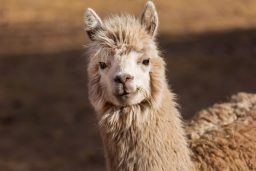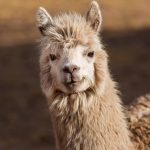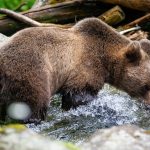The main differences between llamas and alpacas are their ears, coat type and body shape (and maybe their attitude). They also have different ancestors too.
The Differences Between Llamas And Alpacas:
These two small South American camelids (yes, they are both related to the giant 1 and 2 humped camels you see elsewhere) are easy to get confused.
They both look about the same shape and they are often kept together in herds – or you can’t tell the difference between them and so think they are kept together in herds!
Also, read our article “Are Llamas Or Alpacas More Aggressive”
So, as it isn’t so simple to tell them apart in pictures or real-life until you know what you are looking for – here is a breakdown of the key things to look out for:
Ears: Llama Ears Are Totally Unmistakable:

You don’t have to look too hard at the ears of the animal in front of you to know whether it is a Llama or an Alpaca – they are totally different.
The Llama is descended from the wild Guanaco (pronounced gwan-AH-co) and they are both larger camelids – the ears to match.
The Llamas’ ears can be over 20cm (8in) tall and are also curved inwards at the tip – and are often called ‘banana ears’. Wild guanacos have straight ears though.
These giant ears can be swiveled right down behind the head to warn of impending anger – and a possible ‘spit’ coming your way – something the Llamas are famous for.
Usually, they spit out a mixture of air and part-digested plant material at each other to determine or reinforce social dominance – although the odd annoying human can be put in their place too!
An alpaca on the other hand has much smaller, more rigid triangular ears with a noticeable pointed tip. Most often these ears are half-buried within a dense hairdo – so only the tiny tips can be seen. They can still show anger with their flattened ears – and also spit if they have to.
Size: Llamas Are Enormous Compared To Alpacas:
Llamas were domesticated as a pack animal originally – with the Moche and Incan cultures heavily reliant on them. Therefore, the bigger the better.
Unlike their Old World relatives, llamas are not strong enough to carry the weight of humans – just products.
The llama was selectively bred for their patience and endurance as well as their carrying ability and so they got much larger than their wild cousins.
Standing at around 1.7m (5ft 7in) at the eyes – so most humans have to look up at a llama’s face – however alpacas often only reach up to your chest.
The average heights of alpacas at the shoulder are around .8m (2ft 6in). Alpacas weren’t bred for carrying anything – so they didn’t need to get any bigger.
Face Shape: Alpacas Have Short Teeny Faces:
Another big tell-tale difference is their face shape. Llamas have a really long face that in most individuals looks like a cross between a camel and a mule – with quite a pronounced jowl in the short-haired or shorn animals.
Their eyes are huge and they often have their bottom teeth protruding out of their split lip at the front – especially when ‘chewing the cud’.
Alpacas have an altogether shorter, more pointed face – much more sheep-like overall. They often have a thick coat covering their whole head and neck, with only their eyes, snout, and mouth showing as smooth. Often they are shaved entirely to leave only a mop of hair atop their heads. They have a much more compact nose and mouth and are hardly ever seen with their bottom teeth sticking out.
What Are the Main Differences Between Wolverines and Badgers?
Wolverines vs badgers: key differences lie in their physical characteristics and behavior. Wolverines possess a stocky build with muscular bodies, while badgers are relatively smaller and have a flattened shape. Wolverines are regionally widespread, whereas badgers are primarily found in North America, Europe, and Asia. Additionally, wolverines are known for their solitary nature, while badgers often live in social groups called clans.
Coat: Alpacas Fur Is Dense & Crimpy
Alpacas are famous for their amazingly soft and durable wool – the world over. They have some of the softest fibers of any animal – apart from their own wild relative the vicuna (pronounced vi-COON-ya) – but they are much more tolerable of humans and can be trained.
Wild vicunas are very timid and flighty and are often found way up snowy mountains at high altitudes to avoid other animals. Their coats are also water and flame retardant – both amazing qualities indeed.
Alpacas certainly have thicker hair overall and when shorn they are left with a thick bushy coat all over. Llamas still produce decent wool – mainly for domestic use such as rugs and ropes.
You can also get very long-haired llamas but their coat is usually shaggy and drooping down rather than fuzzy like an alpaca. Both can get shorn once a year just like sheep – but usually in the case of the alpaca – this wool is so much more valuable.









